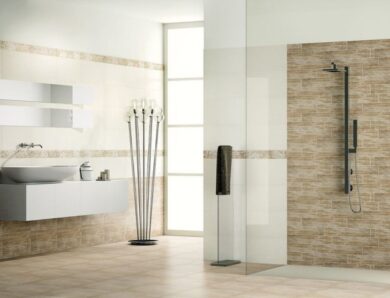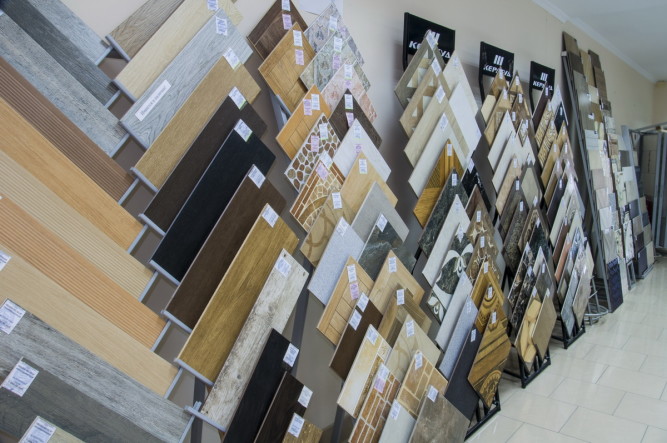How to cut a tile with a Bulgarian without chips: features of work
During self-repair work, a Bulgarian woman is often used to cut the tiles, usually, it is used when working with strong facing material or simply because of lack of a tile cutter. However, to make an incision with such a tool without chips is not so simple. To keep the surface of the tile smooth, you need to know some subtleties of such work. so, let's take a closer look, how to cut a tile Bulgarian.
Cutting tiles Bulgarian has certain features, which must be taken into account, so as not to spoil the material
Features of working with the tool
In the course of facing works you will inevitably face necessity to adjust the sizes of a tile.. Tile cutters in different variations are usually used to make the incision, as well as handy tools. If a glass cutter is enough for a wall tile, thick floor material is much harder to break. Is it possible to cut such a ceramic tile with a Bulgarian?
Bulgarian is one of the most popular tools, which in addition to its direct task in the form of grinding surfaces can also perform other functions. With its help cut metal, ceramic tile, stone and other durable materials.
Thanks to a special nozzle with the help of the Bulgarian it is possible to cut even thick strong porcelain tile
As for the tiles, working with a Bulgarian woman has its own peculiarities. In order to complete the task you will need a special nozzle and a clamp for the tile. Everything else the tool will do for you.
For additional protection, you should put a cap on the Bulgarian, Of course, it will reduce the usability of the tool, but will protect you from splinters and the disk itself.
used nozzles
Cutting of a tile by the Bulgarian is carried out by means of a diamond grinding wheel. This nozzle can be made in several variations. A circle with a fine diamond coating is mainly used for this type of work, designed for dry cutting. Of course, there will be a lot of dust, but so you can make a neat incision.
If you plan to work for a long time, a wet cutting wheel can be used to prevent the tool from overheating. In this case, you will need to additionally arrange the water supply. You can do this manually, using a sprayer, or just immerse the disc in water.
To protect against possible failure of the nozzle before starting work, you need to carefully inspect the tool and securely fasten all its parts. To protect against dust and sharp circles, in addition to the protective cap for the Bulgarian, also use goggles, mask and gloves.
Diamond wheel for Bulgarian can be used in both dry and wet cutting
How to cut a tile
Now let's move directly to the process itself and consider, how to work with a tool, to make an incision without chips and with a minimum amount of dust. Regarding this nuance, there are three directions:
- Straight cut. This type of work is the simplest. To cut a ceramic tile with a Bulgarian in a straight line, in the first place, it is necessary to fix it on a flat surface in this way, so that the edge remains on the weight along the cut line. You need to keep the tool like this, so you can see the direction of the cut, that is, the circle will move "on itself". It is important to follow safety rules.
- At an angle to 45 degrees. Cutting tiles at an angle is a little trickier. In order to make a Bulgarian oblique cut, you must first saw the tile at a right angle. Then the diamond wheel is directed as follows, so that it can be used to remove excess material at an angle. You can bring the edges to the ideal with sandpaper.
- Hole in the tile. This type of work is suitable only for cutting large diameter holes. In order to cut it with a Bulgarian, you must first apply the contours of the circle on the front side with a marker. Then straight lines, located crosswise at right angles to each other to mark the center point. Then start sawing. The Bulgarian should be directed at an angle, so that the circle makes a small indentation in the circle of the hole on the inside of the line of the tent. Gradually shifting, evenly sawing tile. When you get deep enough, sawed straight lines. You need to carefully pull out in turn 4 car sector.
Options for cutting tiles with a Bulgarian
Prerequisite to prevent chipping: it is necessary to work exclusively on the front side of a tile. This way you will damage the top layer less, and defects on the reverse side will be hidden by the solution when laying. After execution the inscription of edge of a tile is processed by an emery cloth, stuffed on a bar, therefore, anticipate the possibility of grinding some of the facing material.
How to turn a Bulgarian into a tile cutter
It is not always convenient to keep the Bulgarian in a hanging position and do all the work only by hand. You will need an assistant to improve the quality of the spray. However it will be much more rational to turn the usual grinder into analog of an electric tile cutter..
We found out, how to properly cut ceramic tiles with a Bulgarian. The same principles of operation are maintained for tile cutters, but you have both hands free. Consider, what to do, to improve this tool.
First of all, choose a suitable place for the location of the machine. The base of the future tile cutter can be made of sheet metal, in which the gutter for deepening of a disk will be cut. All works will be carried out from this line, in addition, such a label will be much easier to navigate.
The most important stage is the fixation of the Bulgarian. Special clamps must be used to secure the tool in position. Their analogue can be made yourself, but there is a risk, that the mounting bolts will break during work.
For frequent use and convenience, the Bulgarian can be fixed, making it a tile cutter
This version of the homemade electric tile cutter can be improved, adding to it a tank of water and a nozzle for wet cutting. This will help avoid dust and cool the tool.
After fixing the Bulgarian, you can conduct a test cut. The principle of operation is as follows: the tile is laid on the labels, the Bulgarian turns on and the disk slowly lowers. The tile will be sawn on the front side, at the same time it is necessary to submit it from itself.
If the work is done correctly, you will get a ceramic tile cut in half with neat edges, without chips, cracks and jags. The final look of the tile can be given with fine sandpaper.



